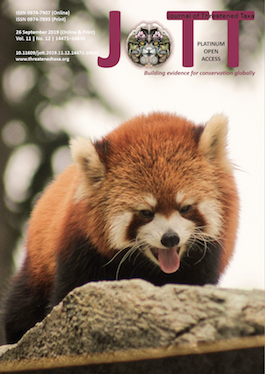Report of five interesting avian species from Durgapur ecoregion, West Bengal, India by citizen science effort
Main Article Content
Abstract
This study aimed to report a few lesser known species from Durgapur ecoregion, West Bengal, India. In spite of the anthropogenic pressure, Durgapur supports a high avian diversity. So far, 257 avian species belonging to 59 families were recorded with a citizen science effort during a period of more than five years (2013–present). Out of these, five species discussed here, are either not recorded previously or have few records: Hume’s Lark and Graceful Prinia were recorded from riverine habitat; and Lesser Racket-tailed Drongo, White-rumped Shama, and Indian Blue-Robin were recorded from woodland habitat. More extensive exploration of this region with involvement of citizen scientists in this study will enrich our knowledge about bird diversity, their migration and distribution pattern in this region.
Article Details
Authors own the copyright to the articles published in JoTT. This is indicated explicitly in each publication. The authors grant permission to the publisher Wildlife Information Liaison Development (WILD) Society to publish the article in the Journal of Threatened Taxa. The authors recognize WILD as the original publisher, and to sell hard copies of the Journal and article to any buyer. JoTT is registered under the Creative Commons Attribution 4.0 International License (CC BY), which allows authors to retain copyright ownership. Under this license the authors allow anyone to download, cite, use the data, modify, reprint, copy and distribute provided the authors and source of publication are credited through appropriate citations (e.g., Son et al. (2016). Bats (Mammalia: Chiroptera) of the southeastern Truong Son Mountains, Quang Ngai Province, Vietnam. Journal of Threatened Taxa 8(7): 8953–8969. https://doi.org/10.11609/jott.2785.8.7.8953-8969). Users of the data do not require specific permission from the authors or the publisher.
References
Ali, S. (2012). The book on Indian Birds, 13th edition. Oxford University Press, Oxford, 326pp.
Baidya, K., S. Das, S. Prasad & K.S. Ray (2017) Banglar Pakhpakhali, Part 1. Forest Dwellers, Malda, 555pp. (In Bengali).
Chakrabarti, K. (1989). Industrialisation and its impact on the tribal peoples a case study of Durgapur steel plant vis a vis tribal peoples in the area. PhD Thesis. Department of Sociology, University of Calcutta, IV+255pp.
Chakraborty, R. (2011). Mammalian and avian faunal diversity in Damodar Valley under DVC project area. Records of the Zoological Survey of India 328: 1–38.
Cohn, J.P. (2008). Citizen Science: Can Volunteers Do Real Research? BioScience 58(3): 192-197. https://doi.org/10.1641/B580303
Devictor, V., R.J. Whittaker & C. Beltrame (2010). Beyond scarcity: citizen science programmes as useful tools for conservation biogeography. Diversity and Distributions 16(3): 354–362. https://doi.org/10.1111/j.1472-4642.2009.00615.x
eBird (2017). eBird: An online database of bird distribution and abundance [web application]. eBird, Ithaca, New York. Accessed 28 December 2017.
Gauntlett, F.M. (1971). Durgapur Barrage as a waterbird habitat. Journal of the Bombay Natural History Society 68(3): 619–632.
Gauntlett, F.M. (1985). The birds of Durgapur and the Damodar valley. Journal of the Bombay Natural History Society 82(2): 501–539.
Grimmett, R., C. Inskipp & T. Inskipp (2011). Birds of India, 2nd edition. Princeton University Press, Princeton, 528pp.
Gupta, S., A. Mukherjee, D. Palit, P. Chatterjee & I. Biswas (2013). A reporting on Wire-tailed Swallows (Hirundo smithii) winter visit to Durgapur Barrage, West Bengal, India. Zoo’s Print 28(8): 22–24.
Hossain, A. & G. Aditya (2016). Avian diversity in agricultural landscape: records from Burdwan, West Bengal, India. Proceedings of the Zoological Society 69(1): 38–51. https://doi.org/10.1007/s12595-014-0118-3
Khan, M.M.H. (2005). Species diversity, relative abundance and habitat use of the birds in the Sundarbans East Wildlife Sanctuary, Bangladesh. Forktail 21: 79–86.
Maulick, R. & S. Adhurya (2017). A report of the Dollarbird Eurystomus orientalis from southern West Bengal. Indian Birds 13(3): 84.
Nayak, A.K., S. Adhurya & U.S. Roy (2015). First record of Common Babbler Turdoides caudata (Timaliidae) from Burdwan district, West Bengal and range extension to Eastern India. Zoo’s Print 30(7): 12–13.
Roy, M.B., B. Chatterjee, T. Mukherjee & P.K. Roy (2016). Environmental threat to wetland bio-diversity of migratory bird: a case study of peri-urban area of West Bengal. Asian Journal of Current Research 1(1): 30–38.
Silvertown, J. (2009). A new dawn for citizen science. Trends in Ecology & Evolution 24(9): 467–471. https://doi.org/10.1016/j.tree.2009.03.017
Theobald, E.J., A.K. Ettinger, H.K. Burgess, L.B. DeBey, N.R. Schmidt, H.E. Froehlich, C. Wagner, J. HilleRisLambers, J. Tewksbury, M.A. Harch & J.K. Parrish (2015). Global change and local solutions: Tapping the unrealized potential of citizen science for biodiversity research. Biological Conservation 181: 236–244. https://doi.org/10.1016/j.biocon.2014.10.021

